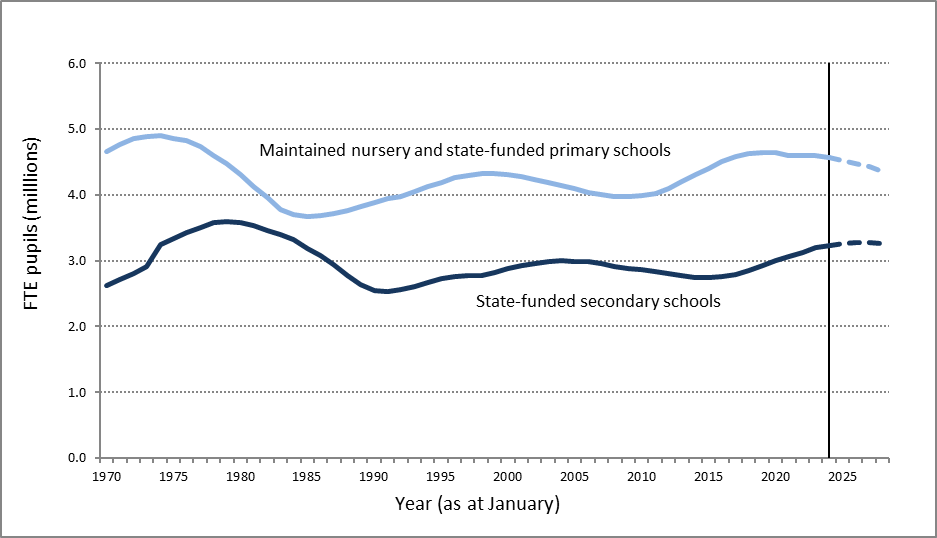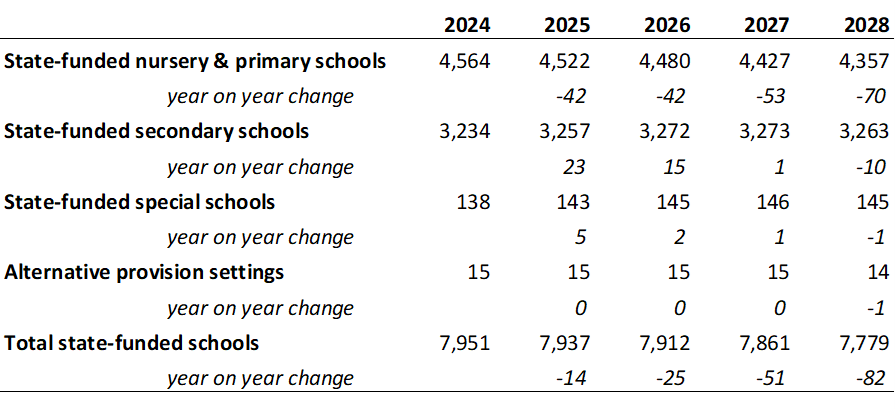Historic and projected pupil numbers by main school type, England

- In this release projections are only provided up to 2028 due to the uncertainty in fertility assumptions from 2029, when impacted births will reach the main school population.
- Figures are reported as full time equivalent (FTE) unless specified otherwise.
- The actual population in state-funded schools[1] in 2024 was 7,951,000. This is projected to decrease by 172,000 (to 7,779,000) over the next four years to 2028.
- The projection model previously published in 2023 estimated a state-funded school population of 7,519,000 in 2028, so the current projection, while still showing a decline, has an estimated 260,000 more pupils than the previous projection for 2028. The trend is unchanged between the two models.
- Last year the pupil projections were calculated on different source data to that usually used, as the ONS population estimates (including the historic estimates which are rebased after the census results are known) and projections did not at that point take account of the 2021 Census.
- New source data affects the model because changes to the actual population numbers lead to different participation rates which are then applied to projected total populations. For example, if participation rates stay the same but the future total population projection numbers are higher, then the calculation between the two will result in higher projected pupil numbers. In addition, if more children are identified in the most recent school census than was previously expected (because of more arrivals from abroad or the private sector for example) then participation rates will also be affected.
[1] Up to and including age 15 at the start of the academic year
Comparison of the results from the 2023 and 2024 pupil projection models

Early years
- Early years calculations include 4 year olds in reception class, which almost all children attend, as well as the younger ages where participation in the state-funded sector is much smaller and there are more part-time pupils.
- The FTE population of under 5 year olds in state funded education is projected to be 780,000 in 2028. This is a 4.4% decrease from the actual figure for 2024 (816,000).
- This population decrease is due to lower births, both actual for 2022 and 2023 and also projected up to 2028. However, the decrease is less than previously projected. One reason for this could be the new migration assumptions in the ONS population data which results in more women of childbearing age than previously projected.
State-funded nursery & primary schools
- The overall pupil population in these school types is projected to be 4,357,000 in 2028. This is 207,000 (4.5%) lower than the actual population in 2024 (4,564,000).
- The projection for 2028 is 176,000 higher than was forecast in the model published in 2023, an increase of 4.2% from last years’ projection.
- The nursery & primary population is therefore still projected to drop, but at a slower rate than previously projected.
State-funded secondary schools
- The secondary school population is projected to be 3,263,000 in 2028. This is 29,000 higher than the total in 2024 (3,234,000).
- The figure for 2028 is 72,000 higher than was forecast in the model published in 2023, a difference of 2.2%.
- The pattern of change in the secondary school population (peaking in 2026 and 2027 then slowly starting to drop) is broadly unchanged, although the peak is two years later than in the previous projections.
Actual (2024) and projected pupil numbers by school type, England (thousands)
